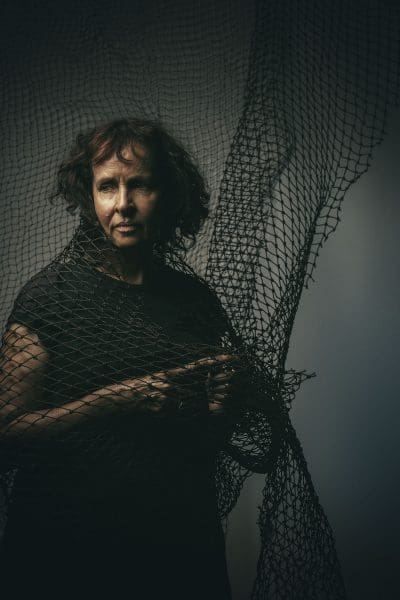
Piercing the veil
A new exhibition at Buxton Contemporary finds a rich complexity in the shadowy terrain between life and death.
In our third feature story on artists and writers with shared interests, Indigenous artist Judy Watson and writer Louise Martin-Chew reminisce about childhood holidays on Stradbroke Island, just off the coast near Brisbane.
It is hard to know what the essential element is that may bind us to a particular place, and what may draw us back there, repeatedly. For me, Stradbroke Island exerts a pull like nowhere else. Perhaps it is the imprint it had on my childhood, the holiday routine that begins with the journey across Moreton Bay. The barge back then was like a large metal bathtub, exposed in an often punishing sun as it traversed the bay with the cars inside like so many Jonahs within the whale. A noisy docking was overseen by wheeling sea birds opportunistically taking disturbed fish, with dolphins observing some 20 metres off the bow. On arrival, the unloading of the barge is still followed by the quietude of the drive across the island: the whispering bush, the low and variable hum of cicadas, mirages that appear and disappear on the heat of the undulating road, and then the increasing glimpses of sea as you get close to the mecca of Point Lookout.
While much has changed since the 1960s, when the roads were dirt, wild ponies grazed behind fibro beach shacks and the only commercial operation was the pub, what is constant is Stradbroke’s extreme weather and the variety in its landscapes, the spectacular beaches, the walk around the Gorge at the easternmost tip, the secluded Whale Watch tracks that meander high above the beach under the canopy of thick bush, and the inland lakes.
Watson first travelled to “Straddie” with her parents as a child and she remembers her hair and clothing being torn at by the wind on Main Beach, where her father and brother headed for some surf fishing. The Gorge Walk, its entry and exit only 100 metres apart, is Narnia-like in its magic. It is a journey across and over clefts of cliff above the blow-hole, offering vantage points from which we can see into the worlds of the turtles, dolphins, rays, and sharks of the Point. The hush in its centre, in the fulcrum of the gorge, is in dramatic contrast to the bluster of its northern and southern arms. The points of the gorge are the defining experiences: to be physically buffeted by the wind, to feel and absorb the sounds of place, its ancient contest with the ocean, and to gaze out to sea all the way to the horizon.

As an artist, Watson’s touchstone, since the 1990s, has been her own country in Lawn Hill, north-west Queensland, a place where she says, “The land knows you when you walk through there and you are looked after.”
However, another of her early experiences on Stradbroke relates directly to her contemporary art practice. “Driving in through the back of Stradbroke’s 19 Mile beach, we came across a fresh water lagoon, a cup-shaped water hole like a vessel with its embedded form,” she recalls. “I remember the clarity of the water, strange with its tannin colour, yet with beams of light shining through it. It was like a chalice, a beautiful sacred vessel within this place and its purity.”
Water and fluidity inform Watson’s practice. Her unframed stained canvases move on the wall with the air, and objects and motifs emerge with a swimming subtlety. The vessel shape often appears on her canvases, and it can also be seen in freshwater lens, 2009, which she made after a residency on Queensland’s Heron Island. This bronze sculpture hangs, with an organic and pregnant weighted shape, from the ceiling.
In more recent years, Watson has spent time on South Stradbroke Island to work with emerging artists. And for tow row, her recent Indigenous sculpture commission for Brisbane’s Gallery of Modern Art (GOMA), she worked with young Quandamooka artist from Stradbroke, Elisa Jane Carmichael.
Watson got to know Carmichael in 2014 at the first Artist’s Camp on Stradbroke Island and Carmichael contributed weaving techniques to Watson’s concept for the public artwork which was unveiled in November 2016 for GOMA’s 10th birthday. This partnership of artists is beautifully realised in tow row. A butterfly shaped fishing net, it is cast in bronze, and conducts light and shadow (depending on the time of day). Its subtle form also draws on research into fishing practices in the nearby Brisbane River, and it poetically represents cultural retrieval.
With tow row now a permanent fixture up the river, there is a sense of a cultural infusion from Stradbroke Island that awaits visitors to this city site. Whether or not it is generally perceived, it is a nice circle of connections for Watson to realise, with Carmichael, a work which may speak to places and peoples connected across the water. For those of us who have an emotional connection to Stradbroke, one of the gifts of recent years is observing the Quandamooka Indigenous presence on the island grow palpably, since their actual ownership was acknowledged through their native title claim in 2011.

Watson, an inveterate traveller, finds place an intrinsic presence in her work: “I am the vessel, walking around, with the water within me, and then there’s an osmosis within all of the other places that I go to,” she says. “I always want to know what’s channelling through those places, lifting the cloak of history to reveal what’s beneath and reacting to the here and now.”
Watson embedded her knowledge of Stradbroke’s magic into tow row, now a physical and cultural experience in the heart of Brisbane. For me, this sculpture is a nice reminder, in the temperate city, of the wildness and wilderness that awaits, patiently throughout millennia, just off the coast.
cross-currents: from island to mainland
Gold Coast Art Centre, Foyer Gallery
9 September – 5 November